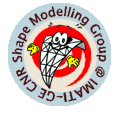General Info
News&Events
Past Events
|
|
|
Who we are
The Shape Modelling Group is a research team of the
Institute of Applied Mathematics and Information Technology, branch of Genova (IMATI-Ge), of the Italian
National Council of Research
(CNR).
The Institute for Applied Mathematics was founded in the 70s, in consequence of the new and
increased potentialities and application needs of mathematics, due to the availability of the new information
technologies.
Geometric modelling has been a key research topic at IMATI-Ge for several years. Geometric modelling is a set of
mathematical and computer science techniques which relate to different fields, such as geometry, computational
topology and computer graphics. The main aim is to describe the shape of an object or phenomenon, through the
definition of geometric primitive entities and the classification of the reference context. By "shape" we
identify an entity having a specific geometry and meaning associated.
Lately the Shape Modelling Group has been constituted with the aim of broadening the role of traditional modelling
with the definition of new
representations, able to highlight the semantic level at which the perception of shape is encoded.
|
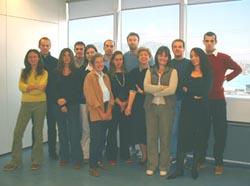
|
|
|
Where we are
CNR-IMATI Ge
Via De Marini 6, 16149 Genova, Italy
tel. +39 010 6475669
fax. +39 010 6475660
Genova is far more beautiful than many people would expect! If you would like to know more about our city, please visit the home site of Comune di Genova:
http://www.turismo.comune.genova.it/
|

|
|
|
The Newsletter NoSMOG
There is a new section in the web site, dedicated to the brand new newsletter of the Shape Modeling Group. The Newsletter NoSMOG is now available for download here.
|
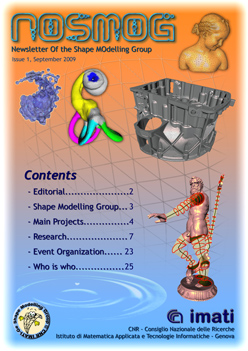
|
|
|
|
|
Special Issue of COMPUTING: Archives of Scientific Computing Mathematical Methods for
Shape Analysis and Processing
Guest Editors: Bruno Levy, Dietmar Saupe and Michela Spagnuolo
The Journal
Presenting the latest research results from computer science and numerical computation,
Computing is an international journal intended for professionals and students
in all fields of scientific computing, for computer center staff, and software and hardware manufacturers.
Each issue features original papers and short communications from a wide range of areas:
discrete algorithms, symbolic computation, performance and complexity evaluation,
operating systems, scheduling, software engineering, picture processing,
parallel computation, classical numerical analysis, numerical software,
numerical statistics, optimization, computer arithmetic, efficient algorithms for large-scale problems, plotting.
For further details, here is the link to the journal web page.
Fields of Interest
Numerical Computing: classical fields plus numerical software,
numerical statistics, optimization, arithmetic, efficient algorithms for large-scale problems.
Informatics: e.g. computer architecture, operating systems, parallel computation, graphics, discrete algorithms.
Emphasis: computational relevance, scientific computing.
Special Issue
The volume and type of information made available via the web is increasing
at an extraordinary speed and search engines have become the preferred interaction
tools for engaging with this data deluge. Search and retrieval of 3D media, or digital shapes,
will rapidly become a key issue in the upcoming panorama of multimedia content: 3D is indeed expected
to represent a huge amount of traffic and data stored in the Internet.
Search and retrieval of digital shapes are traditionally approached by
finding effective abstract descriptions and by defining efficient methods to estimate the similarity among them,
via the computation of some distance measure among descriptors.
In this context, the special issue will provide an overview of recent advances in the area,
focusing on mathematical methods for defining and extracting descriptors,
as well as on methods to use them for retrieval and classification, structure recovery,
and conversion between representations.
Perspective papers should address theoretical, computational or
application problems related to mathematical methods for shape analysis and understanding.
These include, but are not limited to:
- Geometric-topological methods
- Laplacian eigenfunctions
- Spectral analysis
- Statistical methods
- Level-set methods
- Scale-space methods
- Medial Axis
Important deadlines
| |
| Abstract | 1 November 2007 |
| Paper | 15 November 2007 |
| Notification | 15 February 2008 |
| Camera-ready | 15 April 2008 |
Further information and submission instructions will be posted here. For any other information feel free to contact the guest editors
at computing-SI@ge.imati.cnr.it.
|

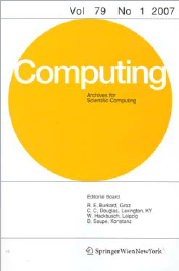
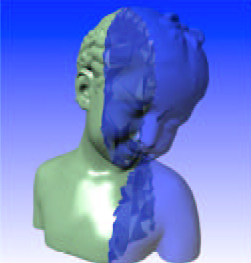
|
|
|
AIM@SHAPE:
Advanced and Innovative Models And
Tools for the development of Semantic-based systems for Handling, Acquiring, and Processing knowledge Embedded
in multidimensional digital objects
What are the common characteristics of shapes? They all have a geometry,
they can be described by structures (object features and part-whole decomposition), they have attributes
(colours, textures, names, attached to an object, its parts and/or its features), they have a semantics
(meaning, purpose), and they possibly evolve in time (e.g. shape morphing, animation, video...).
AIM@SHAPE is a Network of Excellence aimed at coordinating research on representing,
modelling and processing knowledge related to digital shapes.
- Funding Organization: European Commission
- Funding Programme: IST Information Society Technologies - Network of Excellence
- Key Action: 2.3.1.7 Semantic-based knowledge systems
- Starting Date: 1 January 2004
- Duration: 48 months
- Coordinator: IMATI-Ge
- Partners:
DISI - Università di Genova - Italy;
EPFL - Swiss Federal Institute of Technology - Switzerland;
IGD - Fraunhofer - Germany;
INPG - Institut National Polytechnique de Grenoble - France;
INRIA - France;
CERTH - Center for Research and Technology Hellas - Greece;
UNIGE - Université de Genève - Switzerland;
MPII - Max-Planck-Institut für Informatik - Germany;
SINTEF - Norway;
Technion CGGC - Israel;
TUD - Darmstadt University of Technology - Germany;
UU - Utrecht University - The Netherlands;
WIS - Weizmann Institute of Science - Israel.
For more information, please visit the AIM@SHAPE web portal:
http://www.aimatshape.net
|

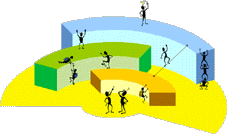

|
|
|
International Convention on Shapes and Solids 2004:
SMI'04 & SM'04 Joint Conference here in Genova!!!
The Shape Modeling International Conference (SMI) and the
ACM Symposium on Solid Modeling and Applications (SM) are two of the most important annual events that deal
with the theoretical and algorithmic foundations for modeling and visualizing real or virtual shapes in a variety of
manufacturing, engineering, biomedical scientific or entertainment applications.
To stimulate the interaction
between these two communities, the two events have been scheduled one after the other, as part of the
Convention on Shapes and Solids (SMI&SM’04) which has been held in Genova, Italy.
Each event has retained
its own Chairs, program committee, paper selection process, and proceedings. However, the two have shared tutorials
and keynote lectures, and a social program on Wednesday June 9, culminating with a dinner in the Shark and Dolphin
Halls of the Genova Aquarium.
Here is a picture of the hall hosting the convention: the wonderful Sala del Maggior Consiglio, at Palazzo Ducale.
For more information, visit the convention web page:
http://smism04.ge.imati.cnr.it
where you can also find some preliminary information about the next Convention on Shapes and Solids,
which will be held at MIT Cambridge, Massachusetts, USA, June 13 to 17, 2005.
http://deslab.mit.edu/SM-SMI-2005
|
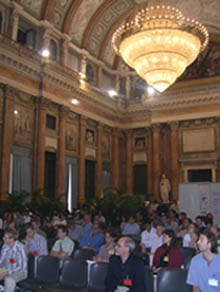
|
|
|
